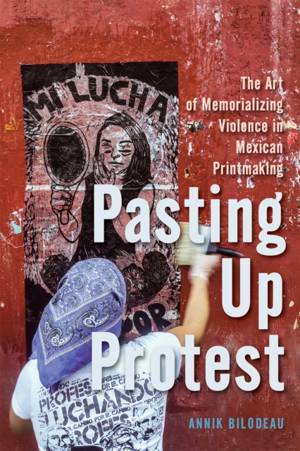
- Afhalen na 1 uur in een winkel met voorraad
- Gratis thuislevering in België vanaf € 30
- Ruim aanbod met 7 miljoen producten
- Afhalen na 1 uur in een winkel met voorraad
- Gratis thuislevering in België vanaf € 30
- Ruim aanbod met 7 miljoen producten
Zoeken
€ 46,45
+ 92 punten
Omschrijving
Across Mexico, human rights abuses take many forms, as do the strategies designed to denounce and resist them. Political street art thrives; murals, stencils, and posters challenge authorities and commemorate the missing and the disappeared. Pasting Up Protest explores the sociopolitical engagement of contemporary Mexican artists, introducing the concept of memory activism, the guiding philosophy behind their efforts to expose human rights violations such as forced disappearances and feminicides. Through her analysis of street art interventions from the collectives ASARO, URT-Arte, ARMARTE, and MuGRe over the past decade, Annik Bilodeau argues that these artists are shaping a new collective memory. By depicting real-life victims and referencing past acts of state-sponsored violence, their works create a familiar visual vocabulary that elicits empathy and compassion in the viewer. A reliance on a tradition of printmaking, a highly reproducible medium, further amplifies the emotional impact of the images. A critical examination of the role of art in creating public memory, Pasting Up Protest sheds light on how Mexican artists document crimes of the state, transforming citizens into political agents of change.
Specificaties
Betrokkenen
- Auteur(s):
- Uitgeverij:
Inhoud
- Aantal bladzijden:
- 344
- Taal:
- Engels
- Reeks:
Eigenschappen
- Productcode (EAN):
- 9780228025580
- Verschijningsdatum:
- 14/10/2025
- Uitvoering:
- Paperback
- Formaat:
- Trade paperback (VS)
- Afmetingen:
- 152 mm x 226 mm
- Gewicht:
- 476 g

Alleen bij Standaard Boekhandel
+ 92 punten op je klantenkaart van Standaard Boekhandel
Beoordelingen
We publiceren alleen reviews die voldoen aan de voorwaarden voor reviews. Bekijk onze voorwaarden voor reviews.








